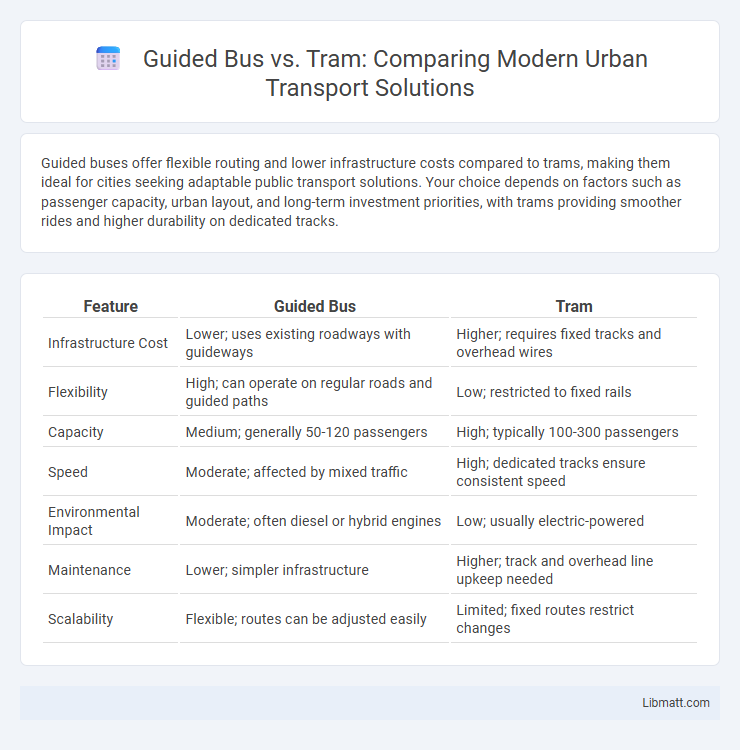Guided buses offer flexible routing and lower infrastructure costs compared to trams, making them ideal for cities seeking adaptable public transport solutions. Your choice depends on factors such as passenger capacity, urban layout, and long-term investment priorities, with trams providing smoother rides and higher durability on dedicated tracks.
Table of Comparison
| Feature | Guided Bus | Tram |
|---|---|---|
| Infrastructure Cost | Lower; uses existing roadways with guideways | Higher; requires fixed tracks and overhead wires |
| Flexibility | High; can operate on regular roads and guided paths | Low; restricted to fixed rails |
| Capacity | Medium; generally 50-120 passengers | High; typically 100-300 passengers |
| Speed | Moderate; affected by mixed traffic | High; dedicated tracks ensure consistent speed |
| Environmental Impact | Moderate; often diesel or hybrid engines | Low; usually electric-powered |
| Maintenance | Lower; simpler infrastructure | Higher; track and overhead line upkeep needed |
| Scalability | Flexible; routes can be adjusted easily | Limited; fixed routes restrict changes |
Overview of Guided Bus and Tram Systems
Guided bus systems operate on dedicated tracks or guideways with steering assistance, combining features of buses and trams for flexible urban transit solutions. Tram systems run on fixed rails embedded into city streets, offering high-capacity, smooth rides with reliable schedules and lower emissions. Both prioritize efficient, sustainable public transportation but differ in infrastructure costs, route flexibility, and capacity management.
Key Differences Between Guided Buses and Trams
Guided buses operate on rubber tires and are steered by physical or optical guidance systems, allowing flexibility to leave and rejoin dedicated tracks, unlike trams which run strictly on fixed steel rails. Trams typically carry more passengers due to their larger size and are powered by overhead electric wires, whereas guided buses may use various propulsion methods including electric, diesel, or hybrid engines. Maintenance and infrastructure costs differ significantly, with guided bus systems requiring less investment in rail track construction but more in guidance technology and road maintenance compared to the fixed rail infrastructure of trams.
Infrastructure Requirements and Costs
Guided buses require less extensive infrastructure compared to trams, as they can operate on existing roadways with minimal modifications, such as guideways or optical sensor tracks, leading to lower initial investment costs. Trams necessitate dedicated rail tracks, overhead electrical lines, and specialized stations, resulting in higher construction and maintenance expenses. The overall cost-efficiency of guided bus systems makes them a flexible urban transit option for cities with budget constraints and evolving transportation needs.
Capacity and Passenger Comfort
Trams typically offer higher passenger capacity than guided buses, accommodating up to 300 passengers per vehicle compared to around 120 in most guided buses. Tram systems provide smoother rides with less vibration and noise due to steel wheels on rails, enhancing passenger comfort on longer journeys. Guided buses offer flexibility in route changes but often sacrifice capacity and ride quality compared to fixed-rail trams.
Flexibility and Route Adaptability
Guided buses offer superior flexibility and route adaptability compared to trams, as they can operate both on dedicated tracks and standard roads, allowing easy route modifications and detours. Trams are constrained to fixed tracks, limiting their ability to adjust routes quickly in response to changing urban demands or emergencies. This flexibility makes guided buses more suitable for dynamic urban environments requiring scalable public transport solutions.
Environmental Impact and Sustainability
Guided buses typically produce lower emissions compared to trams due to their smaller size and lighter weight, making them more energy-efficient over varied routes. Trams, running on electricity often sourced from renewable energy, contribute to zero local emissions and can handle higher passenger volumes with less congestion. Both systems offer sustainable urban transit options, but trams provide longer-term benefits in reducing carbon footprints through durable infrastructure and consistent electric power use.
Speed, Efficiency, and Reliability
Guided buses typically achieve higher speeds than trams due to flexible routing and lighter vehicle weight, enhancing overall travel time efficiency in urban environments. Trams offer superior efficiency in high-capacity transit corridors by maintaining consistent schedules and benefiting from dedicated tracks that reduce traffic interference. Reliability favors trams as fixed rail infrastructure minimizes deviations and delays, while guided buses may face variable road conditions and traffic disruptions impacting punctuality.
Urban Integration and Accessibility
Guided buses offer flexible urban integration by adapting to existing road networks without extensive infrastructure changes, ensuring seamless connectivity within diverse city layouts. Trams require dedicated tracks, which can enhance accessibility through fixed routes and smooth rides but may limit route flexibility and increase urban disruption during installation. Your choice depends on balancing the need for adaptable transit solutions with long-term accessibility and urban planning goals.
Maintenance and Operational Costs
Guided buses typically incur lower maintenance and operational costs compared to trams due to their lighter vehicles and simpler infrastructure requirements. Trams demand significant investment in rail tracks, overhead electrical systems, and specialized maintenance facilities, leading to higher ongoing expenses. Operational costs for trams are often offset by higher passenger capacity and energy efficiency, but guided buses offer more flexible route options with generally reduced lifecycle costs.
Future Trends in Urban Transit: Guided Bus vs Tram
Future trends in urban transit highlight the increasing adoption of guided buses due to their flexibility, lower infrastructure costs, and ability to navigate existing road networks, making them a practical solution for expanding urban mobility. Trams remain popular for their capacity to move large numbers of passengers efficiently and contribute to sustainable urban development with zero-emission electric power. Your city's transit planning may benefit from weighing cost-effectiveness, scalability, and environmental impact when choosing between guided bus systems and tram networks.
guided bus vs tram Infographic

 libmatt.com
libmatt.com